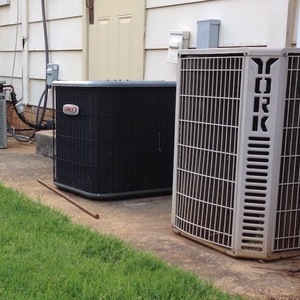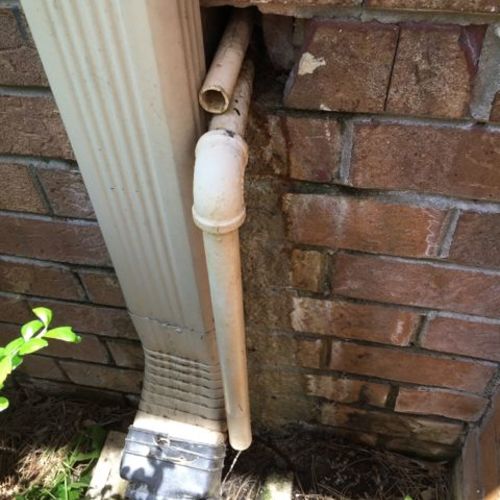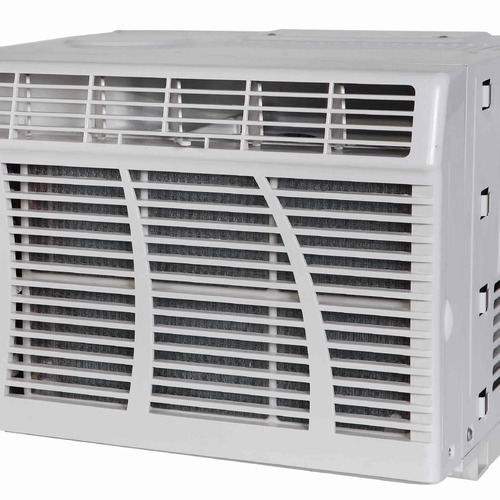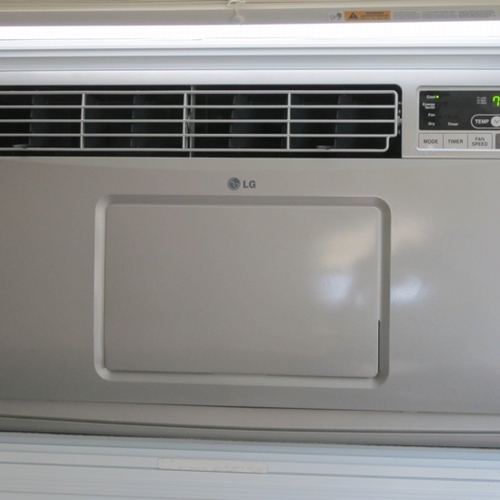
Image Credit: Alex Wilson
[Author’s note: Some modifications have been made since this blog was originally posted.]
I have never owned an air conditioner, and I don’t have any immediate plans to change that. But if I did, what would I look for?
For only occasional use and when you don’t want to spend more than $1,000, the options are limited to room air conditioners, which are most commonly installed in windows. These cool the rooms in which they are installed, though in a small house or one that’s very-well-insulated and tight, a single window unit may be able to cool much of the house.
Most room air conditioners are either installed in a double-hung window or in an opening in the wall specially created for the air conditioner. Special models are available that can be used in casement windows, though installation is trickier.
Window air conditioners are usually installed in the late spring or summer and removed in the fall. Because they don’t seal tightly in the window, they should not be left in place during the winter months, as they will result in cold drafts. Room air conditioners that fit into custom openings through the wall may be left in place as long as they are fairly well-sealing (most are not), and if they are removed the opening should be carefully sealed for the winter.
For whole-house cooling, central air conditioners or heat pumps are used, and chilled air is distributed through ducts. Heat pumps offer the advantage of being able to provide both cooling and heating—by reversing the refrigerant cycle seasonally. If I were putting in an air conditioning system and my budget allowed, I would install one of the new-generation mini-split air-source heat pumps. (Very significant for those of us in the Northeast, the cost of delivered heat from these heat pumps is usually lower than that of oil.)
Room air conditioner efficiencies and performance
Room air conditioner performance is reported as the Energy Efficiency Rating (EER), which is a measure of the energy output in Btus (British Thermal Units) per hour divided by the energy input in watts, assuming standard conditions (usually 95°F outside temperature and 50% relative humidity).
Federally mandated efficiency requirements for room air conditioners vary depending on size, ranging from an EER of 8.5 for models over 20,000 Btu/hour to 9.8 for models in the 8,000 to 14,000 Btu/hour size. To meet the Energy Star standard in these size categories, the EER must be a minimum of 9.4 and 10.8, respectively. The thresholds are somewhat more relaxed for the smallest units.
Today’s best room air conditioners have EERs over 11.5, but relatively few exceed 10.8.
SEER ratings for central air conditioners and heat pumps
Central air conditioners and air-source heat pumps in cooling mode are typically rated on a seasonal bases using the seasonal energy efficiency rating (SEER). This is the total seasonal cooling output in Btus divided by the watt-hours of electricity consumption.
Central air conditioners must have SEER ratings of 13.0 or higher; I don’t think there’s a minimum threshold for the cooling performance of heat pumps [see correction in comments below]. To qualify for the Energy Star standard, central air conditioners and air-source heat pumps both must have SEER ratings of 14.5 for split systems (separate indoor and outdoor components) or 14.0 for packaged units.
The best central air conditioners and air-source heat pumps today have SEER ratings above 22.
Moisture removal with air conditioners
All air conditioners remove moisture, as described in last week’s blog. While there are no federal requirements or measurement standards for moisture removal, most manufacturers list moisture removal in pints of water per hour. As a first step, you must properly size an air conditioner to achieve good moisture removal (see below). If humidity is a problem, look for models that are effective at moisture removal. Models with variable-speed motors are typically more effective at moisture removal.
Discuss moisture removal with a dealer or air conditioning contractor. Your particular situation and humidity conditions may inform the product recommendations.
Sizing air conditioners and heat pumps
Particularly with central air conditioners and heat pumps, sizing is key to successful performance. With an oversized unit, frequent on-off cycling will occur, efficiency will drop, and moisture removal will be poor. Sizing requires carrying out detailed cooling load calculations; it is not something that should be done using rules of thumb. The sizing of ducting with a central unit is also very important, both for efficient operation and noise control.
Making decisions
A knowledgeable air conditioner salesperson should be able to help you pick out a quality room air conditioner. Insist on an Energy Star-listed model, ask about moisture removal, and then consider technical support, warranties, manufacturer reputation, and service in making your buying decision.
With central air conditioners and heat pumps, talk with air conditioning contractors and suppliers, but be aware that specific contractors may push only those products they are most familiar with or manufacturers they represent. The latest mini-split air-source heat pumps from such manufacturers as Mitsubishi, Daikin, Panasonic, and Fujitsu offer—in my opinion—the best option available today.
If the air conditioning contractor you contact doesn’t provide these systems, I would suggest that you seek out other contractors or suppliers before proceeding with a purchase.
Alex is founder of BuildingGreen, Inc. and executive editor of Environmental Building News. He also coauthored BuildingGreen’s special report on windows that just came out. To keep up with Alex’s latest articles and musings, you can sign up for his Twitter feed.
Weekly Newsletter
Get building science and energy efficiency advice, plus special offers, in your inbox.















7 Comments
What about load calculations?
That's not a bad start for someone who's never owned an air conditioner, Alex. :~) For those of us in the Southeast, who have difficulty even imagining life without air conditioning anymore, there's a bit more about this subject that should be said. First, let's go right to the humidity issue. You said:
If humidity is a problem, look for models that are effective at moisture removal.
The first step, though, would be to make sure you get an air conditioner that's not oversized. To do that, you need to know what size is appropriate. The most common way to do that is with software based on the Manual J heating and cooling load calculation protocol from the Air Conditioning Contractors of America. It's not just about getting the right type of equipment.
Also, I'm pretty sure that heat pumps are not excluded from the minimum SEER rule and have to be rated at 13 SEER or higher, same as air conditioners. I don't know that I've actually seen the rule from the US DOE, but every reference to it I've ever seen puts air conditioners and heat pumps in the same category here.
Then there's the distribution system. Unless you're going with a window unit or ductless mini-split heat pump, you'll need ducts. My advice: Spend more on getting the best duct system you can and forget the super high efficiency equipment. I see people make this mistake all the time, and it's so frustrating to see, for example, an 18 SEER AC attached to a crappy duct system that might be 50% efficient.
And finally, I agree with you about mini-splits. I like them a lot for the reasons you mentioned and more. The condensing units are whisper quiet, and you can get them in smaller sizes, too.
heat pumps are indeed subject to minimum SEER standards
CFR 430.32 covers energy efficiency standards see:
http://bit.ly/MqvLOW
Under the current rule, split heat pumps and air conditioners must have minimum SEER of 13. Beginning January 1, 2015, the minimums change, depending on the region. In the north, straight AC will stay at 13 but heat pumps will increase to 14 SEER. Furnaces in northern states will have to be at least 90%. That part takes affect in less than 10 months!
Here's a summary of the changes from ACEEE. Note: this document pre-dates the final rule, so the implementation schedule shown is incorrect.
http://www.aceee.org/files/pdf/1009hvac_fact.pdf
As for the rest, I'm with Allison... I can't believe I just read an article on choosing an A/C without any mention of proper sizing, especially given the attention to moisture removal. If an air conditioner is significantly oversized (thus leading to short cycling), the coil may never get cold enough to condense any moisture. And BTW, for an air conditioner, moisture removal capacity is typically specified in terms of latent capacity or sensible heat ratio, not in pints per hour. That sounds more like a dehumidifier spec.
Beyond Condensers and Heat Pumps to New Chiller Technologies
IMHO it goes without saying that properly sizing the equipment based on the load calculations (and whether or not buildings are properly air-sealed and insulated, etc.) is necessary, and I suggest Alex presumed readers would instinctively realize that.
Also, an entire article could be written addressing all the steps necessary to properly prepare a building so that loads may be more precisely calculated and correctly sized equipment installed.
I would like to note that Alex did not cover the new chiller technology (water source heat pumps) recently developed by Mestek Industries SpacePak divison, or the SDHV air management technologies that are now sweeping the globe.
Already in use by the US military for years and found in installations on every continent, SDHV systems transcend current rules for minimum SEER requirements. Numerous drafts have been in development for the establishment of the standards for the energy efficiency testing and life-cycle analysis of these systems since about 2000, yet none as of yet have been ratified and adopted by the DOE. See here:
http://www1.eere.energy.gov/buildings/appliance_standards/residential/small_duct_ac.html
Nevertheless, these systems have been gaining in popularity over recent years due to their documented extremely high efficiency. Using super-silent high velocity VFS fans that create an air column which draws air in a room towards it, causing an aspiration effect, it more quickly blends with room-temperature air instead of attempting to replace it. Because these systems don't work on the same principles as conventional HVAC equipment, they use dramatically less energy to process less air more quickly, and standardized testing methods for conventional HVAC systems don't apply.
One of the "coolest" things about these systems is the supply air termination. They're almost invisible in most installations; there are no unsightly supply vent grilles, returns may be nearly anywhere in the envelope. The newest air cell technology even eliminates the need for thermostats, and the DC VSD fan motors use less than 180 watts when running at full capacity, with an average energy consumption of less than a 90 watt light bulb when supplying air to a single zone.
See more here: http://spacepak.com/products/aircell-efficient-airhandler.asp
The SEER equivalency ratings might be well into the 30's, and because it does process a smaller amount of air so much more quickly, it draws the humidity out at nearly three times the rate of a conventional HVAC system.
There's also an interesting slideshow on the FutureSource Initiative at http://abidesystems.com that points out requirements for current and upcoming DOE building efficiencies.
Texas Summers
I have always been taught that when a customer is bordering on needing the next size unit to oversize the AC. The prevailing wisdom here is that choosing to oversize AC units here because of the extreme summer heat keeps the unit from straining under peak load and results in more efficient operation. My acedotal experience bears this out. If somone has studies to the contrary I would like to see them.
high velocity not inherently more efficient
@Mic, the tenor of your comment sounds like you have a vested interest in promoting this product. I'm aware of the rulemaking attempt for SDHV systems such as SpacePak and Unico. There's a good reason this has gone nowhere. While these systems are great for solving access issues -- for example, in older homes with radiators -- it's ludicrous to think high velocity systems are somehow inherently more efficient than similar conventional systems, since all else being equal, HV blowers consume more power per BTU delivered. That's why they've had trouble meeting Federal minimum efficiency ratings.
Comparisons touted on the manufacturer's websites are never based on equivalent systems -- PSC vs PSC, ECM vs ECM, ducts inside the envelope vs ducts inside the envelope. Tight ducts vs tight ducts. SDHV propoents always like to compare to a non-equivalent (poor) baseline. These companies would have you believe their equipment is better than everything else, all the time. It's simply not true.
The argument for establishing a separate efficiency procedure originated with the idea that these systems have tighter ducts with significantly less surface area than conventional equipment. Less surface area means less conducted heat loss to unconditioned spaces and smaller leakage paths. True enough. However, reduced duct surface area provides virtually no benefit if the ducts are installed inside the envelope. Virtually all of the systems I design have conventional duct systems inside the envelope, and all are verified to meet strict air leakage standards.
More importantly, duct system efficiency should never be reflected in manufactured equipment ratings since design and installation practice has such a large impact on in-situ performance.
Admittedly I'm unfamiliar with spacepak's new new ground source chiller and aircell technology, but if it uses high static, high velocity air distribution, it cannot be as efficient as a similar product on an apples-apples basis.
Dave Butler's comment vs RP Mick's
Ironically, there was an ad for Unico on this very page, and it captured my interest.
I think new technology is a good thing and we need some out of the box thinking.
If the chillers can remove 30% more moisture out of the air in HOT and Humid climates, I think it might be worth a try.
Has anyone reading this ever had one installed in their home?
As I found out first hand with over sized air conditioners, if it short cycles, it is a good case for black mold issues in the house.
Single Zone Mini Split Air Conditioners & Ductless Heat Pumps
Browse single zone mini split air conditioners and ductless systems. We stock a wider variety of single-zone mini split air conditioners and ductless heat pumps. These single zone mini split air conditioners can be used for your home or office.
See more here: https://www.minisplitwarehouse.com/category/single-zone-heat-pump-air-conditioners
Log in or create an account to post a comment.
Sign up Log in